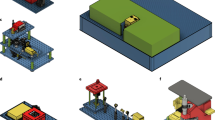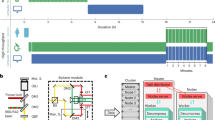Abstract
Single-molecule localization microscopy (SMLM) enables imaging scientists to visualize biological structures with unprecedented resolution. Particularly powerful implementations of SMLM are capable of three-dimensional, multicolor and high-throughput imaging and can yield key biological insights. However, widespread access to these technologies is limited, primarily by the cost of commercial options and complexity of de novo development of custom systems. Here we provide a comprehensive guide for interested researchers who wish to establish a high-end, custom-built SMLM setup in their laboratories. We detail the initial configuration and subsequent assembly of the SMLM, including the instructions for the alignment of all the optical pathways, the software and hardware integration, and the operation of the instrument. We describe the validation steps, including the preparation and imaging of test and biological samples with structures of well-defined geometries, and assist the user in troubleshooting and benchmarking the system’s performance. Additionally, we provide a walkthrough of the reconstruction of a super-resolved dataset from acquired raw images using the Super-resolution Microscopy Analysis Platform. Depending on the instrument configuration, the cost of the components is in the range US$95,000–180,000, similar to other open-source advanced SMLMs, and substantially lower than the cost of a commercial instrument. A builder with some experience of optical systems is expected to require 4–8 months from the start of the system construction to attain high-quality three-dimensional and multicolor biological images.
Key points
-
The authors describe the complete configuration and assembly of a custom-built single-molecule localization microscope, including optical alignment, software and hardware integration, validation steps and benchmarking of the system’s performance.
-
The microscope is optimized for ultra-stable three-dimensional imaging performance and multichannel functionalities, while remaining substantially less expensive than similar commercial systems.
This is a preview of subscription content, access via your institution
Access options
Access Nature and 54 other Nature Portfolio journals
Get Nature+, our best-value online-access subscription
$29.99 / 30 days
cancel any time
Subscribe to this journal
Receive 12 print issues and online access
$259.00 per year
only $21.58 per issue
Buy this article
- Purchase on Springer Link
- Instant access to full article PDF
Prices may be subject to local taxes which are calculated during checkout










Similar content being viewed by others
Data availability
All CAD parts and assemblies, mechanical drawings and electronic board files are available from the project repository: https://github.com/ries-lab/3DSMLM. All materials provided in the repository are licensed under a Creative Commons Attribution-NonCommercial-ShareAlike 4.0 International License (CC-BY-NC-ND-4.0). The sequences of raw images that were localized and rendered to produce Figs. 9 and 10 can be provided on request.
Code availability
The user interface, FPGA firmware and modified µManager device adapters are available from the project repository (https://github.com/ries-lab/3DSMLM). All materials provided in the repository are licensed under a Creative Commons Attribution-NonCommercial-ShareAlike 4.0 International License (CC-BY-NC-ND-4.0). The analysis software, SMAP which is used used throughout the Protocol, is available at https://github.com/jries/SMAP.
References
Betzig, E. et al. Imaging intracellular fluorescent proteins at nanometer resolution. Science 313, 1642–1645 (2006).
Hess, S. T., Girirajan, T. P. K. & Mason, M. D. Ultra-high resolution imaging by fluorescence photoactivation localization microscopy. Biophys. J. 91, 4258–4272 (2006).
Rust, M. J., Bates, M. & Zhuang, X. Sub-diffraction-limit imaging by stochastic optical reconstruction microscopy (STORM). Nat. Methods 3, 793–795 (2006).
Heilemann, M., Van De Linde, S., Mukherjee, A. & Sauer, M. Super-resolution imaging with small organic fluorophores. Angew. Chem. Int. Ed. Engl. 48, 6903–6908 (2009).
Jungmann, R. et al. Single-molecule kinetics and super-resolution microscopy by fluorescence imaging of transient binding on DNA origami. Nano Lett. 10, 4756–4761 (2010).
Martens, K. J. A. et al. Visualisation of dCas9 target search in vivo using an open-microscopy framework. Nat. Commun. 10, 3552 (2019).
Auer, A. et al. Nanometer-scale multiplexed super-resolution imaging with an economic 3D-DNA-PAINT microscope. ChemPhysChem 19, 3024–3034 (2018).
Ma, H., Fu, R., Xu, J. & Liu, Y. A simple and cost-effective setup for super-resolution localization microscopy. Sci. Rep. 7, 1542 (2017).
Diederich, B. et al. Nanoscopy on the chea(i)p. Preprint at bioRxiv https://doi.org/10.1101/2020.09.04.283085 (2020).
Zehrer, A. C., Martin-Villalba, A., Diederich, B. & Ewers, H. An open-source, high resolution, automated fluorescence microscope. eLife 12, RP89826 (2023).
Alsamsam, M. N., Kopūstas, A., Jurevičiūtė, M. & Tutkus, M. The miEye: bench-top super-resolution microscope with cost-effective equipment. HardwareX 12, e00368 (2022).
Coelho, S. et al. Ultraprecise single-molecule localization microscopy enables in situ distance measurements in intact cells. Sci. Adv. 6, eaay8271 (2020).
Mau, A., Friedl, K., Leterrier, C., Bourg, N. & Lévêque-Fort, S. Fast widefield scan provides tunable and uniform illumination optimizing super-resolution microscopy on large fields. Nat. Commun. 12, 3077 (2021).
Stehr, F., Stein, J., Schueder, F., Schwille, P. & Jungmann, R. Flat-top TIRF illumination boosts DNA-PAINT imaging and quantification. Nat. Commun. 10, 1268 (2019).
Khaw, I. et al. Flat-field illumination for quantitative fluorescence imaging. Opt. Express 26, 15276 (2018).
Niederauer, C., Seynen, M., Zomerdijk, J., Kamp, M. & Ganzinger, K. A. The K2: open-source simultaneous triple-color TIRF microscope for live-cell and single-molecule imaging. HardwareX 13, e00404 (2023).
Jabermoradi, A., Yang, S., Gobes, M. I., Van Duynhoven, J. P. M. & Hohlbein, J. Enabling single-molecule localization microscopy in turbid food emulsions. Philos. Trans. R. Soc. A. 380, 20200164 (2022).
Li, Y. et al. Global fitting for high-accuracy multi-channel single-molecule localization. Nat. Commun. 13, 3133 (2022).
Roy, R., Hohng, S. & Ha, T. A practical guide to single-molecule FRET. Nat. Methods 5, 507–516 (2008).
Ha, T. et al. Probing the interaction between two single molecules: fluorescence resonance energy transfer between a single donor and a single acceptor. Proc. Natl Acad. Sci. USA 93, 6264–6268 (1996).
Huang, B., Wang, W., Bates, M. & Zhuang, X. Three-dimensional super-resolution imaging by stochastic optical reconstruction microscopy. Science 319, 810–813 (2008).
Pavani, S. R. P. et al. Three-dimensional, single-molecule fluorescence imaging beyond the diffraction limit by using a double-helix point spread function. Proc. Natl Acad. Sci. USA 106, 2995–2999 (2009).
Danial, J. S. H. et al. Constructing a cost-efficient, high-throughput and high-quality single-molecule localization microscope for super-resolution imaging. Nat. Protoc. 17, 2570–2619 (2022).
Carter, N., Cross, R. & Martin, D. Warwick open-source microscope. https://wosmic.org/ (2016).
Edwards, J., Whitley, K., Peneti, S., Cesbron, Y. & Holden, S. LifeHack microscope. GitHub https://github.com/HoldenLab/LifeHack (2021).
Deschamps, J., Rowald, A. & Ries, J. Efficient homogeneous illumination and optical sectioning for quantitative single-molecule localization microscopy. Opt. Express 24, 28080 (2016).
Li, Y. et al. Real-time 3D single-molecule localization using experimental point spread functions. Nat. Methods 15, 367–369 (2018).
Deschamps, J. & Ries, J. EMU: reconfigurable graphical user interfaces for Micro-Manager. BMC Bioinforma. 21, 456 (2020).
Diekmann, R. et al. Optimizing imaging speed and excitation intensity for single-molecule localization microscopy. Nat. Methods 17, 909–912 (2020).
Ries, J. SMAP: a modular super-resolution microscopy analysis platform for SMLM data. Nat. Methods 17, 870–872 (2020).
Dasgupta, A. et al. Direct supercritical angle localization microscopy for nanometer 3D superresolution. Nat. Commun. 12, 1180 (2021).
Diekmann, R. et al. Photon-free (s)CMOS camera characterization for artifact reduction in high- and super-resolution microscopy. Nat. Commun. 13, 3362 (2022).
Ries, J., Kaplan, C., Platonova, E., Eghlidi, H. & Ewers, H. A simple, versatile method for GFP-based super-resolution microscopy via nanobodies. Nat. Methods 9, 582–584 (2012).
Mund, M. et al. Systematic nanoscale analysis of endocytosis links efficient vesicle formation to patterned actin nucleation. Cell 174, 884–896.e17 (2018).
Mund, M. et al. Clathrin coats partially preassemble and subsequently bend during endocytosis. J. Cell Biol. 222, e202206038 (2023).
Cieslinski, K. et al. Nanoscale structural organization and stoichiometry of the budding yeast kinetochore. J. Cell Biol. 222, e202209094 (2023).
Edelstein, A., Amodaj, N., Hoover, K., Vale, R. & Stuurman, N. Computer control of microscopes using manager. Curr. Protoc. Mol. Biol. https://doi.org/10.1002/0471142727.mb1420s92 (2010).
Deschamps, J., Kieser, C., Hoess, P., Deguchi, T. & Ries, J. MicroFPGA: an affordable FPGA platform for microscope control. HardwareX 13, e00407 (2023).
Schermelleh, L. et al. Super-resolution microscopy demystified. Nat. Cell Biol. 21, 72–84 (2019).
Vangindertael, J. et al. An introduction to optical super-resolution microscopy for the adventurous biologist. Methods Appl. Fluoresc. 6, 22003 (2018).
Jacquemet, G., Carisey, A. F., Hamidi, H., Henriques, R. & Leterrier, C. The cell biologist’s guide to super-resolution microscopy. J. Cell Sci. 133, jcs240713 (2020).
Bond, C., Santiago-Ruiz, A. N., Tang, Q. & Lakadamyali, M. Technological advances in super-resolution microscopy to study cellular processes. Mol. Cell 82, 315–332 (2022).
Hell, S. W. & Wichmann, J. Breaking the diffraction resolution limit by stimulated emission. Opt. Lett. 19, 780–782 (1994).
Gustafsson, M. G. Surpassing the lateral resolution limit by a factor of two using structured illumination microscopy. J. Microsc. 198, 82–87 (2000).
Müller, C. B. & Enderlein, J. Image scanning microscopy. Phys. Rev. Lett. 104, 1–4 (2010).
Strauss, M. T. Picasso-server: a community-based, open-source processing framework for super-resolution data. Commun. Biol. 5, 1–3 (2022).
Ovesný, M., Křížek, P., Borkovec, J., Švindrych, Z. & Hagen, G. M. ThunderSTORM: a comprehensive ImageJ plug-in for PALM and STORM data analysis and super-resolution imaging. Bioinformatics 30, 2389–2390 (2014).
Sage, D. et al. Super-resolution fight club: assessment of 2D and 3D single-molecule localization microscopy software. Nat. Methods 16, 387–395 (2019).
Von Appen, A. et al. In situ structural analysis of the human nuclear pore complex. Nature 526, 140–143 (2015).
Thevathasan, J. V. et al. Nuclear pores as versatile reference standards for quantitative superresolution microscopy. Nat. Methods 16, 1045–1053 (2019).
Smith, C. S., Joseph, N., Rieger, B. & Lidke, K. A. Fast, single-molecule localization that achieves theoretically minimum uncertainty. Nat. Methods 7, 373–375 (2010).
Wu, Y.-L. et al. Maximum-likelihood model fitting for quantitative analysis of SMLM data. Nat. Methods 20, 139–148 (2023).
Acknowledgements
We thank C. Kieser (EMBL Electronic Workshop) for help with construction of and documentation for the microFPGA. We thank A. Milberger (EMBL Mechanical Workshop) for providing all mechanical drawings. We thank J. Deschamps (Human Technopole, Milan, Italy) for providing the EMU htSMLM user interface and continued support in various aspects of microscope control. We thank A. Roy for assistance in testing the protocol. This work was supported by the European Research Council (CoG-724489) and the European Molecular Biology Laboratory. We acknowledge the access and services provided by the Imaging Centre at the European Molecular Biology Laboratory, generously supported by the Boehringer Ingelheim Foundation.
Author information
Authors and Affiliations
Contributions
R.M.P. and J.R. designed and developed the microscope hardware. A.T. and J.R. performed sample preparation. R.M.P., A.T. and J.R. performed imaging and data analysis. T.Z. and J.R. provided project supervision. All authors wrote the manuscript and designed the protocol.
Corresponding authors
Ethics declarations
Competing interests
The authors declare no competing interests.
Peer review
Peer review information
Nature Protocols thanks Carlas Smith and the other, anonymous, reviewer(s) for their contribution to the peer review of this work.
Additional information
Publisher’s note Springer Nature remains neutral with regard to jurisdictional claims in published maps and institutional affiliations.
Related links
Key references
Li, Y. et al. Nat. Methods 15, 367–369 (2018): https://doi.org/10.1038/nmeth.4661
Diekmann, R. et al. Nat. Methods 17, 909–912 (2020): https://doi.org/10.1038/s41592-020-0918-5
Deschamps, J. et al. HardwareX 13, e00407 (2023): https://doi.org/10.1016/j.ohx.2023.e00407
Thevathasan, J. V. et al. Nat. Methods 16, 1045–1053 (2019): https://doi.org/10.1038/s41592-019-0574-9
Wu, Y.-L. et al. Nat. Methods 20, 139–148 (2023): https://doi.org/10.1038/s41592-022-01676-z
Extended data
Supplementary Information
Supplementary Information
Supplementary Notes 1–26, Protocols 1–8, Troubleshooting, Figs. 1–67 and References.
Supplementary Tables
Supplementary Tables 1–13.
Rights and permissions
Springer Nature or its licensor (e.g. a society or other partner) holds exclusive rights to this article under a publishing agreement with the author(s) or other rightsholder(s); author self-archiving of the accepted manuscript version of this article is solely governed by the terms of such publishing agreement and applicable law.
About this article
Cite this article
Power, R.M., Tschanz, A., Zimmermann, T. et al. Build and operation of a custom 3D, multicolor, single-molecule localization microscope. Nat Protoc (2024). https://doi.org/10.1038/s41596-024-00989-x
Received:
Accepted:
Published:
DOI: https://doi.org/10.1038/s41596-024-00989-x
Comments
By submitting a comment you agree to abide by our Terms and Community Guidelines. If you find something abusive or that does not comply with our terms or guidelines please flag it as inappropriate.



